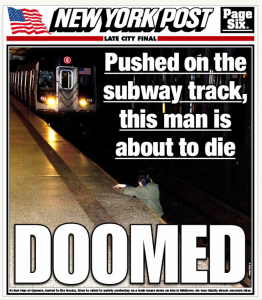
When journalism meets humanity
By Kevin Woo, Robinson Marketing | December 6, 2012
Earlier this week Ki Suk Han was pushed by an unknown man onto the subway tracks in New York. Twenty-two seconds later Ki was hit by an oncoming train and died.
The story, of course, isn’t that simple. Ki’s struggle to lift himself onto the subway platform was captured by photo journalist R. Umar Abbasi. The New York Post ran a photo of Ki hanging onto the wall of the subway platform as an oncoming train barreled down the tracks right at him.
Many are questioning why Abbasi chose to shoot pictures instead of helping Ki to safety.
This raises an important question about the media – are they there to report or help? It’s easy, too easy, to say that in this instance Abbasi should have put down his camera to try and save Ki.
But what about journalists who put themselves in harms way to interview terrorists or photograph wars? If a journalist conducts an interview with a known terrorist does he or she have an obligation to the U.S. government to disclose the terrorist’s whereabouts?
If a photo journalist happens upon a starving child while shooting pictures in a foreign country is he obligated to help that child find food? Some would say yes while others might say, “He’s there to do a job, not feed the hungry.”
I don’t have the answers as I can see both sides of the argument. Mr. Abbasi is a photo journalist and did what came naturally to him – he took pictures. Does that make his actions wrong? I’m not sure.
What are your thoughts?
Kevin Woo is a partner at Robinson Marketing and Public Relations and is also a freelance journalist.